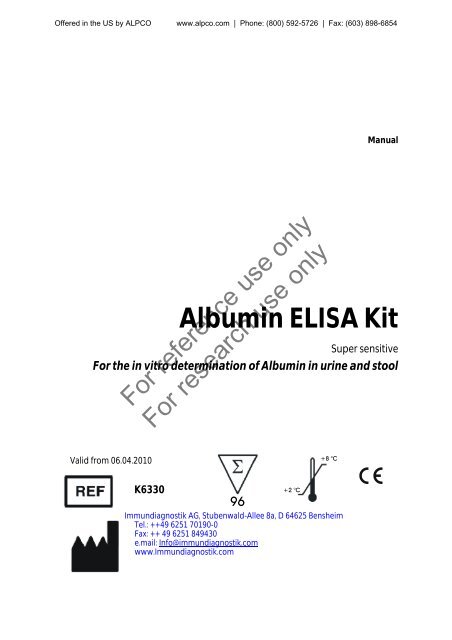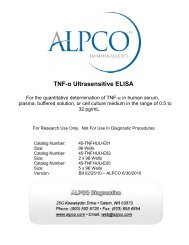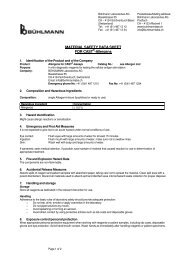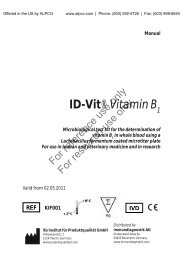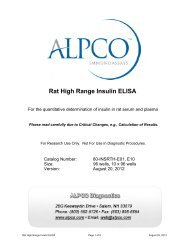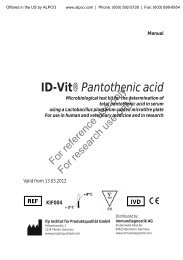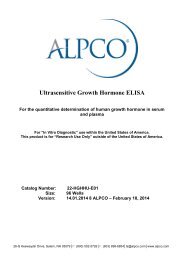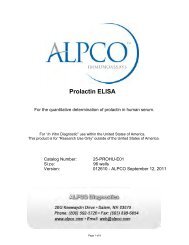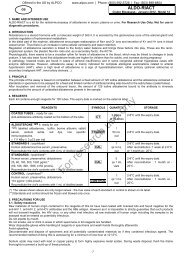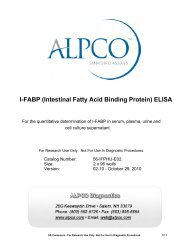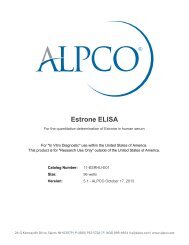Albumin ELISA Kit - ALPCO Diagnostics
Albumin ELISA Kit - ALPCO Diagnostics
Albumin ELISA Kit - ALPCO Diagnostics
Create successful ePaper yourself
Turn your PDF publications into a flip-book with our unique Google optimized e-Paper software.
Offered in the US by <strong>ALPCO</strong> www.alpco.com | Phone: (800) 592-5726 | Fax: (603) 898-6854Manual<strong>Albumin</strong> <strong>ELISA</strong> <strong>Kit</strong>Super sensitiveFor the in vitro determination of <strong>Albumin</strong> in urine and stoolFor reference use onlyFor research use onlyValid from 06.04.2010+8 °CK633096+2 °CImmundiagnostik AG, Stubenwald-Allee 8a, D 64625 BensheimTel.: ++49 6251 70190-0Fax: ++ 49 6251 849430e.mail: Info@immundiagnostik.comwww.Immundiagnostik.com
Offered in the US by <strong>ALPCO</strong> www.alpco.com | Phone: (800) 592-5726 | Fax: (603) 898-68541. INTENDED USEThe Immundiagnostik Assay is intended for the quantitative determinationof <strong>Albumin</strong> in urine and stool. For in vitro diagnostic use only.2. SUMMARY AND EXPLANATION OF THE TEST<strong>Albumin</strong> is the major protein in human plasma (40-60%). It is synthesized inthe liver depending of the protein uptake. <strong>Albumin</strong> in fecal samples refers toan inflammatory reaction combined with intestinal bleeding. Elevated levelsof albumin and hemoglobin in stool are found not only by colorectalcarcinomas, but also with polyps and during chronic inflammatory diseases(Morbus Crohn or Colitis Ulcerosa).Indication• Detection of source of bleeding in the lower gastrointestinal tract• Detection of colorectal carcinoma• Investigation of high risk patients• Morbus Crohn, Colitis Ulcerosa3. PRINCIPLE OF THE TESTThis Enzyme-Linked Immunosorbent Assay (<strong>ELISA</strong>) is a two step assay forthe ultra sensitive determination of human albumin in stool and urine. Apolyclonal rabbit antibody specific for human albumin is immobilized on amicrotiter plate and a second anti-albumin antibody is conjugated toperoxidase (POD).In a first incubation step, the albumin in the samples is bound to theimmobilized anti-albumin antibodies. A washing step is carried out toremove all unbound substances. In a second incubation step, a POD-labeledanti-albumin antibody is added. After another washing step, to remove allunbound substances, a POD-substrate, tetramethylbenzidine (TMB), isadded. The enzymatic reaction is terminated by an acidic stop solution,whereby the color converts from blue to yellow. The intensity of the yellowcolor is directly proportional to the concentration of albumin in the sample.A dose response curve of the absorbance unit (optical density, OD) vs.concentration is generated using the results obtained from the calibrators.<strong>Albumin</strong> in the patient samples is determined directly from this curve.For reference use onlyFor research use only
Offered in the US by <strong>ALPCO</strong> www.alpco.com | Phone: (800) 592-5726 | Fax: (603) 898-68544. MATERIAL SUPPLIEDCat. No Label <strong>Kit</strong> Components QuantityK 6330MTP PLATE Precoated strips 96K 6330WP WASHBUF <strong>ELISA</strong> wash buffer concentrate (10x) 1 x 100 mlK 6330PV SAMPLEBUF Sample dilution buffer, ready to use 1 x 100 mlK6330VPK 6330KK 6330STCONJBUFCONJSTDConjugate dilution buffer,ready-to-useConjugate, (rabbit-anti-<strong>Albumin</strong>peroxidase-labeled)Calibrators, lyophilized(0, 12.5, 50, 200, 800 µg/l)For reference use onlyFor research use only1 x 15 ml1 x 50 µl4 x 5 vialsK 6330KO1 CTRL Control, lyophilized 4 x 1 vialK 6330KO2 CTRL Control, lyophilized 4 x 1 vialK 6330TMBSUBTMB substrate (Tetramethylbenzidine),ready-to-use1 x 15 mlK 6330AC STOP <strong>ELISA</strong> stop solution, ready to use 1 x 15 ml5. MATERIAL REQUIRED BUT NOT SUPPLIED• Bidistilled (aqua bidest.) and sterile water• Laboratory balance• Precision pipettors calibrated and tips to deliver 5-1000 µl• Foil to cover the microtiter plate• Horizontal microtiter plate shaker• A multi-channel dispenser or repeating dispenser• Centrifuge capable of 3000 x g• Vortex-Mixer• Standard laboratory glass or plastic vials, cups, etc.• Microtiter plate reader at 450 or 405 nm(reference wave length 620 or 690 nm)
Offered in the US by <strong>ALPCO</strong> www.alpco.com | Phone: (800) 592-5726 | Fax: (603) 898-68546. PREPARATION AND STORAGE OF REAGENTS• To run assay more than once, ensure that reagents are stored atconditions stated on the label. Prepare only the appropriate amountnecessary for each assay. The kit can be used up to 4 times within theexpiry date stated on the label.• Reagents with a volume less than 100 µl should be centrifuged beforeuse to avoid loss of volume.• The WASHBUF (wash buffer concentrate) must be diluted with aquabidest. 1:10 before use (100 ml WASHBUF + 900 ml aqua bidest.), mixwell. Crystals could occur due to high salt concentration in the stocksolutions. The crystals must be redissolved at 37°C using a water bathbefore dilution of the buffer solutions. The WASHBUF (wash bufferconcentrate) is stable at 2-8°C until the expiry date stated on the label.Diluted buffer solution can be stored in a closed flask at 2-8°C for onemonth.• The lyophilized STD (calibrators) and the CTRL (controls) must bereconstituted with 500 µl aqua bidest. Allow the vial content to dissolvefor 10 minutes and mix thoroughly by gentle inversion to insurecomplete reconstitution. Reconstituted Calibrators and Controls arenot stable and can not be stored.• The CONJ (conjugate, POD-Antibody) must be diluted 1:400 inCONJBUF (conjugate dilution buffer, e.g. 25 µl CONJ + 10 ml CONJBUF).The CONJ (conjugate, POD-Antibody) is stable at 2 -8 °C until the expirydate given on the label. Diluted antibody is not stable and can not bestored.For reference use onlyFor research use only• All other test reagents are ready for use. The test reagents are stable upto the date of expiry (see label of test package) when stored at2-8°C.
Offered in the US by <strong>ALPCO</strong> www.alpco.com | Phone: (800) 592-5726 | Fax: (603) 898-68547. PRECAUTIONS• For in vitro diagnostic use only.• Human materials used in kit components were tested and found to benegative for HIV, Hepatitis B and Hepatitis C. However, for safety reasons,all kit components should be treated as potentially infectious.• Stop solution is composed of sulfuric acid, which is a strong acid. Evendiluted, it still must be handled with care. It can cause acid burns andshould be handled with gloves, eye protection, and appropriateprotective clothing. Any spills should be wiped out immediately withcopious quantities of water.• Reagents should not be used beyond the expiration date shown on thekit label.8. SPECIMEN COLLECTION AND PREPARATIONUrineAdjust urine to a pH 6 to 8 with 1 N NaOH. Samples can be stored for twoweeks at 2-8 °C or at -20°C for longtime storage.For the assay, dilute samples 1:200 with SAMPLEBUF (sample dilutionbuffer), e.g.10 µl sample +1990 µl SAMPLEBUF (sample dilution buffer).FaecesFor reference use onlyFor research use onlyAdd about 100 mg of the sample (note the sample weight for thecalculation) to 5 ml of wash buffer and mix.Centrifuge the sample suspension for 10 min at 3000 rpm.Dilute supernatant 1:5 in SAMPLEBUF (sample dilution buffer; e.g.200 µl supernatant + 800 µl SAMPLEBUF). Use 100 µl of the obtainedsolution for the test.We recommend to weight fresh stool samples for each run. Supernatant isnot stable and can not be stored.Stool samples can be stored at –20°C for 4 weeks. Avoid repeated freezingand thawing.Immundiagnostik recommends the use of tubes from Roche <strong>Diagnostics</strong>/Mannheim (No. 745804) for sample preparation.
Offered in the US by <strong>ALPCO</strong> www.alpco.com | Phone: (800) 592-5726 | Fax: (603) 898-68549. ASSAY PROCEDUREProcedural notes• Do not interchange different lot numbers of any kit component withinthe same assay.• Quality control guidelines should be observed.• Incubation time, incubation temperature and pipetting volumes of thecomponents are defined by the producer. Any variation of the testprocedure, which is not coordinated with the producer, may influencethe results of the test. Immundiagnostik AG can therefore not be heldresponsible for any damage resulting from wrong use.• The assay should always be performed according the enclosed manual.Test procedureWash the precoated PLATE (microtiter plate) 5 x with 250 µl diluted washbuffer. After the final washing step, the inverted PLATE should be firmlytapped on absorbent paper to remove excess solution. This is valid for allfollowing washing steps. Carry out each determination in duplicate forstandards, controls and samples.1. Add 100 µl STD (Standard), CTRL (Controls) and diluted patientsamples into respective wells.2. Incubate for 1 hour shaking on a horizontal mixer at roomtemperature.3. Decant the content of the PLATE and wash the wells 5 x with 250µldiluted wash buffer.4. Add 100 µl diluted conjugate in each well.5. Incubate for 1 hour shaking on a horizontal mixer at roomtemperature.6. Decant the content of the PLATE and wash the wells 5 x with 250µldiluted wash buffer.7. Add 100 µl SUB (TMB substrate) in each well.8. Incubate for 10-20 minutes at room temperature.9. Add 50 µl STOP (stop solution) in each well and mix shortly.10. Determine absorption immediately with an <strong>ELISA</strong> reader at 450 nmagainst 620 nm (or 690 nm) as reference. If no reference wavelength isavailable, read only at 450 nm. If the extinction of the highest standardexceeds the measurement range of the photometer, absorption mustbe measured immediately at 405 nm against 620 nm (or 690 nm) asreference.For reference use onlyFor research use only
Offered in the US by <strong>ALPCO</strong> www.alpco.com | Phone: (800) 592-5726 | Fax: (603) 898-685410. RESULTSWe recommend the 4-parameter-algorithm for evaluation of the test results.Alternatively, a point-to-point-calculation or a spline-algorithm can be used.Before the automatic evaluation of the results, the plausibility of the pairs ofvalues should be examined. If this option is not available with the usedprogram, a control of the paired values should be done manually.Typical calibration curveFor reference use onlyFor research use onlyConcentration [ng/ml] 800 200 50 12.5 0OD mean values 1.353 1.114 0.687 0.269 0.118The data is for demonstration only and cannot be used for the evaluation oftest results.
Offered in the US by <strong>ALPCO</strong> www.alpco.com | Phone: (800) 592-5726 | Fax: (603) 898-6854FaecesFor the <strong>Albumin</strong> concentration of faeces samples, calculate as described inthe following example:Weight:80 mg (1ml stool = 1g) = 0,08 mlDilution step 1: 5ml / 0,08ml = 62,5Dilution step 2: 5Dilution factor: 312.5Multiply the result by 312.5 to get the concentration of the sample. Thedilution factor depends on the weight of the faeces.UrineTo get the <strong>Albumin</strong> concentration in urine samples the observed valuesmust be multiplied by 200.11. LIMITATIONSSamples with <strong>Albumin</strong> levels greater than the highest calibrator should befurther diluted and re-assayed.12. QUALITY CONTROLImmundiagnostik recommends commercial control samples forinternal quality control.For reference use onlyFor research use onlyControl samples should be analyzed with each run. Results, generated fromthe analysis of control samples, should be evaluated for acceptability usingappropriate statistical methods. The results for the patient samples may notbe valid, if within the same assay one or more values of the quality controlsample are outside the acceptable limits.Expected valuesNormal range<strong>Albumin</strong> in stool: < 9.2 mg/l (n = 76)<strong>Albumin</strong> in urine:5 - 16 mg/l
Offered in the US by <strong>ALPCO</strong> www.alpco.com | Phone: (800) 592-5726 | Fax: (603) 898-685413. PERFORMANCE CHARACTERISTICSPrecision and reproducibilityIntra-AssayThe precision (intra-assay variation) was calculated from 20 replicatedeterminations on one sample.Intra-Assay CV n=20Inter-AssaySample<strong>Albumin</strong>[mg/l]Intra-Assay CV[%]1 50 5The total precision (inter-assay variation) of was calculated from data on onesample obtained in 20 different assays over a period of three months.Inter-Assay CV n = 20SensitivitySample<strong>Albumin</strong>[mg/l]Inter-Assay CV[%]1 50 8For reference use onlyFor research use onlyThe detection limit was set as B 0 + 2 SD and estimated to be 12.5 ng/l. TheZero-standard was measured 20 times.Cross reactivityNo cross reactivity to other plasma proteins in faeces.14. REFERENCES1. Trasch and Bloch: 1993; Clin. Lab. 39, 479-4842. John et al.: 1994; Clin. Lab. 40, 77-81
Offered in the US by <strong>ALPCO</strong> www.alpco.com | Phone: (800) 592-5726 | Fax: (603) 898-6854For reference use onlyFor research use only


